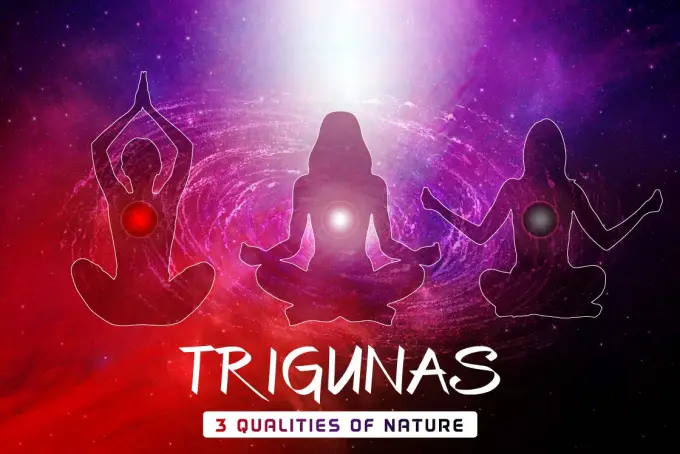The concept of Best Trigunas (Three – 3 Best Gunas – Qualities) of Nature emerged from Ayurvedic philosophy, which provides a picture of the universe’s creation.
According to Ayurvedic philosophy, there was only Darkness (unmanifest) at the beginning of creation, implying Purusha (Consciousness) and Prakriti (Nature). Prakriti and Purusha come together to form the universe (the Female and male aspects of creation)
According to Samkhya Philosophy, both are abstract entities, with Purusha being unaltered or inert and Prakriti remaining dynamic and changeable.
What are the best Gunas?
Trigunas, or three qualities of Nature, are the three modes in which Prakriti shows itself in the matter. Prakriti is made up of three root words.
- Pra means Sattva Guna
- Kr means Rajas Guna
- Ti means Tamas Guna
Trigunas combines different compositions to develop the 5 elements of the body, which is also known as Pancha Maha-Bhoota.
| Triguna/ Combination of Trigunas | Predominant Elements of the Body |
| 1. Sattva | Akasa (Ether) |
| 2. Rajas | Vayu (Air) |
| 3. Sattva + Rajas | Agni (Fire) |
| 4. Sattva + Tamas | Jal (Water) |
| 5. Tamas | Prithvi (Earth)
|
Five more elements merged to produce the tri-doshas.
Characteristics of Best Trigunas
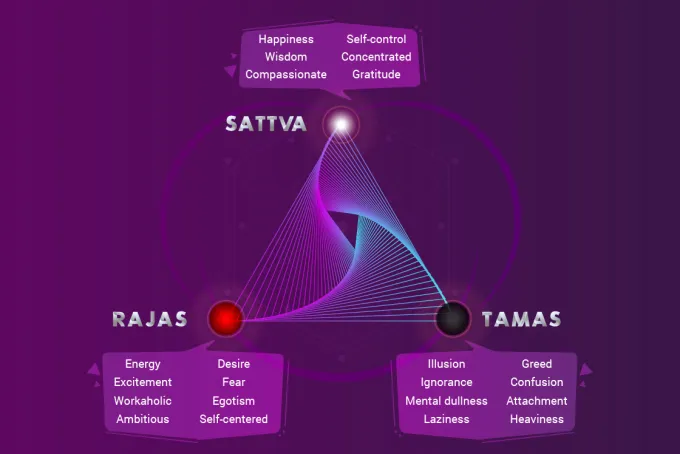
Look around you and within you; everything, alive or non-living, has Triguna’s traits.
The substance around you is moving, and blood flows continuously as a result of Rajas Guna (activity) in nature and the body.
You can stop your mind fluctuations for a bit during meditation practice since Tamas Guna (inertia) is present in your mind.
On the other hand, remember that when your attention wanders from one place to another, it’s due to Rajas Guna. Also, when you are deep in meditation and feel your inner self, the bliss that flows out of it is due to Sattva Guna (balance).
Trigunas can be found anywhere.
Have you gotten the picture?
Sattva Guna Characteristics
Sattva is the state of equilibrium between activity and inertia. Happiness, wisdom, spiritual connection, compassion, lightness in body and mind, self-control, concentration, gratitude, and selflessness are Sattvic state traits. Sattva Guna is represented by the color white.
Rajas Guna Characteristics
Among the best Gunas, Rajas Guna is recognized for its ‘fickling & activity’ state. Rajas Guna’s characteristics include desire, fear, depression, and anxiety, as well as selfishness, excitement, workaholism, ambition, chaos, restlessness, and anger. Rajas Guna is represented by the color red.
Tamas Guna Characteristics
It has an underactive tendency, whereas Rajas Guna is overactive and sattva is balanced. Trigunas have the lowest Tamas or TamoGuna. It is represented by the color dark. Illusion, ignorance, mental dullness, laziness, greed, confusion, attachment, and heaviness are all represented by this symbol.
Trigunas and Personality
You might have heard, this/that person has a good personality. What does personality mean?
In the modern day, Trigunas have been used to explain the concept of personality.
Trigunas are the main features of your existence as a human being that aid in the shaping of all material and immaterial traits in you. These three characteristics, in varying degrees, cause you to behave, react, conceptualize, and perceive the nature of your surroundings differently.
The characteristics of inherited Gunas by an individual can be changed due to physical, psychological, and social influences. Also, it leads to a determination of the behavior of an individual at that particular time.
The proportion of each Guna can change at any time, which has an impact on your personality and attributes associated with a specific Guna or combination of Gunas.
How Best Trigunas Affect Personality?
Any change that occurs in a human being, whether physical, mental, or psychological, has the root 5 elements that comprise the body. These five elements are perceived in the body via the five bodily senses. Furthermore, data gathered through the senses is processed by the mind and intellect before being transformed according to the dominant Guna.
Hence, Guna is the final step that influences the Personality of a person.
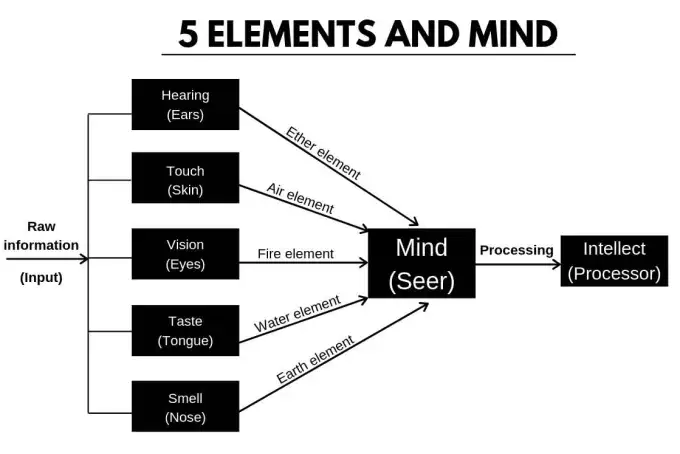
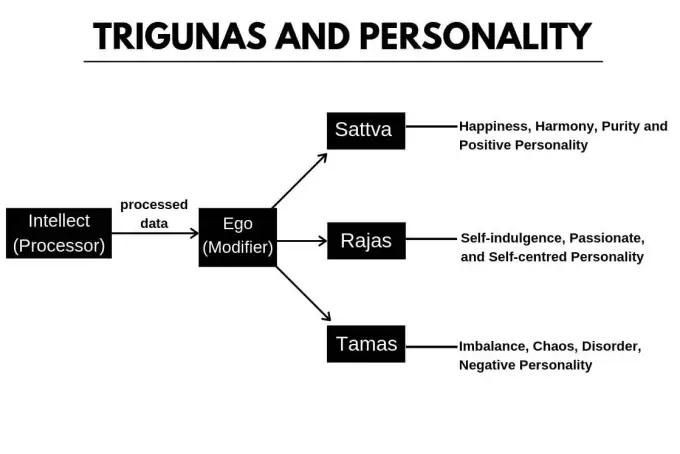
Every individual has an ego through which they perceive processed data based on their intellect (Buddhi). As shown in the above graphic, Trigunas is derived from the ego, which is also known as the I-sensor or modifier and determines a person’s personality.
Finally, what emerges as a result of raw data (collected through the 5 senses) is referred to as a person’s personality, and it is determined by the triggers that are prominent at any one time.
The Person With Sattva Guna
Sattva means “pure,” and hence reveals your personality type. Sattva Guna is the positive and spiritual quality that, when dominant, causes you to be naturally kind and caring, and thus possess Sattvic Personality.
If you are: Sattvic Guna is present in an appropriate proportion in you.
- Mentally Strong
- Respect your Teachers (Gurus)
- Non-violent
- Kindred
- Self-controlled
- Meditative
A person with dominant Sattva Guna is calm towards his work and duty differentiating between desirable and undesirable circumstances.
The more sattvic your nature, the more drawn to love, compassion, kindness, and attachment to happiness you are. As a result, you will remain healthy and disease-free in this state.
There are 7 types of sattvic personality a person is found in. Know here which one you are!
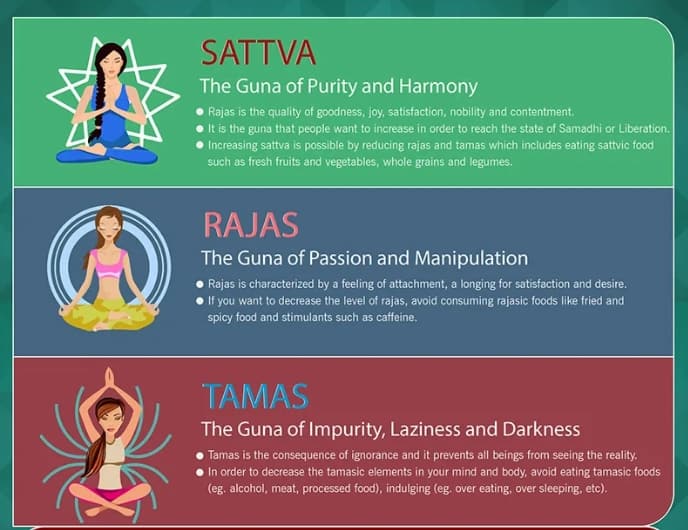
The Person With Rajas Guna
Raja’s people are very desirous and full of attachment. Due to their acute self-interest, sometimes they may face difficulties in differentiating between right and wrong. It’s called Rajasic Personality.
If you are: Rajas Guna is in a balanced proportion.
- Enthusiast
- Deeply Interested
- Dedicated to Work
- Restless
- Self-centered
- Achiever
Raja denotes Passion, which acts as a catalyst or bridge between Sattva and Tamas. Rajas balance Sattva and Tamas to inspire change, movement, and proper action through motivation and creativity.
If a person’s Rajas Guna becomes imbalanced, it has a counter-effect in which the preponderance may increase Anger, Agitation, or Anxiety. There are a few natural ways to reduce the excess of Rajas guna.
The Person With Tamas Guna
Tamas is a Greek word that means “darkness,” and it represents the psychological states of illusion, negativity, dullness, and inaction. Tamas Guna’s dominance is characterized by selfish, indifferent, cynical behavior and is thus referred to as the Tamasic Personality.
When you see a change in your Tamasik Guna, you will notice:
- Timely Sleep
- Balanced Diet
- Openness to others
- Appreciative in nature
- Concerned about others
- Active toward helping others
A person who is unbalanced Tamas Guna’s impacts include fleeting happiness, materialism, possessive sentiments, and a strong desire to harm others.
[efn note] A book Dhanwantri: A Complete Ayurvedic Life Guide [Source] [/efn_note] written by Harish Johari categorized People into 7 types based on the Trigunas. These 7 types are the following.
-
People with dominant Sattva Guna.
-
People with dominant Rajas Guna.
-
People with dominant Tamas Guna.
-
People with a dominant Sattva–Rajas Guna combination.
-
People with dominant Sattva–Tamas Guna combination.
-
People with dominant Rajas–Tamas Guna combination.
-
People with balanced Gunas or with Sattva–Rajas–Tamas Guna combination.
The above list of Best Trigunas shows that:
Trigunas never exist in isolation in a person and always act in conjunction with each other. Even Trigunas compete with each other and dominating Guna decides the Personality of a person.
Until now, you would have known which personality best suited you based on Trigunas.
The challenge now is, how can we utilize Gunas within us for our own and others’ benefit.
The Action & The Intention
Initiation of action begins with the intention behind it. To get the Guna behind the action, Ask yourself these questions every time you begin work:
- Why I am doing this (Intention)
- How I am doing this (Manifestation)
At times in life, you may be doing work with Sattvic intention (Why am I doing this), but its expression (How am I doing this) may be Tamasik or Rajasic.
For example, as a thief, a person stole something to meet the needs of their family. In this case, the thief’s manifestation (how he does it) is Tamasik, but his goal (why he does it) could be Sattvic. Tamas, on the other hand, is the dominating Guna.
If you pay attention to the intention and manifestation of labor, you will be able to balance the dominating Guna. The role of how we react to the outcome of our effort begins here.
Reaction
What you become as a result of your reaction to the outcome of your job is the one that will remain, grow, and reproduce within you.
In the same case, if the thief reflects on his actions (stealing), his heart must be filled with grief, dullness, and disrespect (because sattva was there in his intention).
This cognitive process of reacting to the incident has the potential to change his attitude (albeit it is extremely unlikely) and transform his Tamasik nature into Sattva.
















